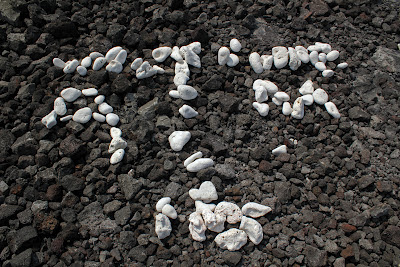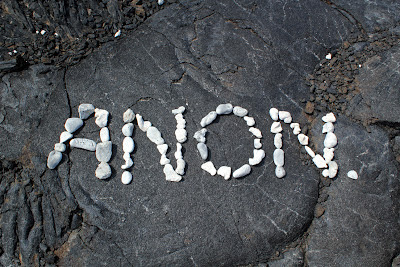Around seven o’clock each evening, music filters up the hill
to my vacation rental in the Kona District from the large dance hall. I can
hear the house band sing about paradise while visitors, retirees and
honeymooners alike, swig down fruity rum drinks and nod to each other in sweet
agreement. The song shifts to the inevitable end of the trip and the lament of
having to return to the cold, hustle-bustle or humdrum existence that awaits
back home, leaving only memories and a desire to return, the latter receiving
it’s own verse. Then the music changes as the island’s drum and dance troupe
rush onto to the stage to whip even the most cynical Poli-Sci or Anthropology
professor into a desire to go back to the room and have one last go at the Missus
before the plane in the morning.
Similar scenes play out on other islands in this chain, as
they do in the Caribbean and other tropical isles around the world. It’s how a
significant number of the locals make a living, the visitors. What is unique about
the Big Island of Hawai’i is that many of the tourists leave behind a mark of
their presence, something they can call their own and hope to someday see
again.
North of the Kona airport the drought-tolerant trees and
grasses give way to fields of dark lava. Little else is here, yet it draws
vacationers and locals alike to pull off of Highway 19 with buckets, plastic
bags or satchels full of dead white coral. Using the pieces and clumps as
markers, they pile lines along the dark ground to spell out their messages of
hope, love and commemoration. This is coral graffiti.
The lava flows are from the volcano Hualalai, which last
erupted in the 1700s. Yet, it is somewhat difficult without further research to
know if some of the flow is from Mauna Loa, which is still very active and has
vents extending into this region. The coral is hauled up from the beaches where
it is found in abundance. It is tempting to draw contrasts of life and death
with these minerals: The coral was once alive and the lava the birth of an
island; the coral bleached white in death and the dark lava denying roots a
hold. Yet, my purpose in such a trajectory would be to merely segue back to
those who combine these elements to leave sentiments less sublime, yet all too
human.
From the highway, it’s as if I’m looking at the leftovers of
a party I wasn’t invited to, the remains of favors and a good time. I have
never seen someone actually do this graffiti. Yet, when I venture out onto the lava, I cannot help but feel
disappointed, for taken individually, so many of the grouped pieces of coral
seem pedestrian in their sentimentality: a couples’ initials surrounded by a
heart, a first name, a home town, a memoriam, and if especially industrious, a
date or some extra decoration in the shape of a star or flower.
There are a few clever or, better still, enigmatic pieces,
and while I did not catalogue every marking left along the one-mile stretch of
road (both sides), I am comfortable with this assessment as a rule. I am
perhaps most amazed by the groupings that are the furthest from the road, as
far as one hundred yards into the lava. The effort is noted and I assume the
trek made to better insure their mark is not disturbed or pilfered by
opportunistic souls with a lesser empathy for others. I dutifully document
these even though the marks themselves are no more special, revealing or
imaginative than those ten feet off the road.
Against these massive fields of lava, we humans are small
things, insignificant except in helping to erode the surface with each step or
in the garbage we leave behind. This is the overwhelming sense I carry with me
as I sweat in the heat and my eyes begin to sting with salt. I step carefully,
knowing that should I take a serious spill or an apparently solid surface give way
to a precipice, I could become more like the coral in a short period. I am less
aware of my humanity and more of my mortality, my piece-of-sand transience. A
memory and sentiment that will both fade long before these stretches of lava
show more signs of life than the occasional tuft of grass.
Such a frame of mind! It perhaps then is no wonder that I
soon tire of J.K.’s undying passion to get into L.M.’s pants via a clump of
dead sea creatures, and instead begin to take special note of the graffiti that
has been dispersed by either vandalism or tectonic rumblings.
Were I otherwise disposed, I suppose I would celebrate the
lovers, feel compassion for the families of those remembered in this way. And
perhaps I could wait until that time to write a more compassionate essay. But I
find it difficult to have such hope out there with the lava and coral that only
serve to reinforce what I want to claim as my own sentiment. Nevertheless, I
must be touched on some level, if ever so slightly against these feelings of
futility, and ultimately come to terms with my own desire to leave a mark... my
mark… a fitting mark.














No comments:
Post a Comment